Rongwu Xu
"Nuclear Deployed!": Analyzing Catastrophic Risks in Decision-making of Autonomous LLM Agents
Feb 17, 2025Abstract:Large language models (LLMs) are evolving into autonomous decision-makers, raising concerns about catastrophic risks in high-stakes scenarios, particularly in Chemical, Biological, Radiological and Nuclear (CBRN) domains. Based on the insight that such risks can originate from trade-offs between the agent's Helpful, Harmlessness and Honest (HHH) goals, we build a novel three-stage evaluation framework, which is carefully constructed to effectively and naturally expose such risks. We conduct 14,400 agentic simulations across 12 advanced LLMs, with extensive experiments and analysis. Results reveal that LLM agents can autonomously engage in catastrophic behaviors and deception, without being deliberately induced. Furthermore, stronger reasoning abilities often increase, rather than mitigate, these risks. We also show that these agents can violate instructions and superior commands. On the whole, we empirically prove the existence of catastrophic risks in autonomous LLM agents. We will release our code upon request.
Long$^2$RAG: Evaluating Long-Context & Long-Form Retrieval-Augmented Generation with Key Point Recall
Oct 31, 2024Abstract:Retrieval-augmented generation (RAG) is a promising approach to address the limitations of fixed knowledge in large language models (LLMs). However, current benchmarks for evaluating RAG systems suffer from two key deficiencies: (1) they fail to adequately measure LLMs' capability in handling long-context retrieval due to a lack of datasets that reflect the characteristics of retrieved documents, and (2) they lack a comprehensive evaluation method for assessing LLMs' ability to generate long-form responses that effectively exploits retrieved information. To address these shortcomings, we introduce the Long$^2$RAG benchmark and the Key Point Recall (KPR) metric. Long$^2$RAG comprises 280 questions spanning 10 domains and across 8 question categories, each associated with 5 retrieved documents with an average length of 2,444 words. KPR evaluates the extent to which LLMs incorporate key points extracted from the retrieved documents into their generated responses, providing a more nuanced assessment of their ability to exploit retrieved information.
Sing it, Narrate it: Quality Musical Lyrics Translation
Oct 29, 2024Abstract:Translating lyrics for musicals presents unique challenges due to the need to ensure high translation quality while adhering to singability requirements such as length and rhyme. Existing song translation approaches often prioritize these singability constraints at the expense of translation quality, which is crucial for musicals. This paper aims to enhance translation quality while maintaining key singability features. Our method consists of three main components. First, we create a dataset to train reward models for the automatic evaluation of translation quality. Second, to enhance both singability and translation quality, we implement a two-stage training process with filtering techniques. Finally, we introduce an inference-time optimization framework for translating entire songs. Extensive experiments, including both automatic and human evaluations, demonstrate significant improvements over baseline methods and validate the effectiveness of each component in our approach.
On the Role of Attention Heads in Large Language Model Safety
Oct 17, 2024



Abstract:Large language models (LLMs) achieve state-of-the-art performance on multiple language tasks, yet their safety guardrails can be circumvented, leading to harmful generations. In light of this, recent research on safety mechanisms has emerged, revealing that when safety representations or component are suppressed, the safety capability of LLMs are compromised. However, existing research tends to overlook the safety impact of multi-head attention mechanisms, despite their crucial role in various model functionalities. Hence, in this paper, we aim to explore the connection between standard attention mechanisms and safety capability to fill this gap in the safety-related mechanistic interpretability. We propose a novel metric which tailored for multi-head attention, the Safety Head ImPortant Score (Ships), to assess the individual heads' contributions to model safety. Based on this, we generalize Ships to the dataset level and further introduce the Safety Attention Head AttRibution Algorithm (Sahara) to attribute the critical safety attention heads inside the model. Our findings show that the special attention head has a significant impact on safety. Ablating a single safety head allows aligned model (e.g., Llama-2-7b-chat) to respond to 16 times more harmful queries, while only modifying 0.006% of the parameters, in contrast to the ~ 5% modification required in previous studies. More importantly, we demonstrate that attention heads primarily function as feature extractors for safety and models fine-tuned from the same base model exhibit overlapping safety heads through comprehensive experiments. Together, our attribution approach and findings provide a novel perspective for unpacking the black box of safety mechanisms within large models.
DebateQA: Evaluating Question Answering on Debatable Knowledge
Aug 02, 2024



Abstract:The rise of large language models (LLMs) has enabled us to seek answers to inherently debatable questions on LLM chatbots, necessitating a reliable way to evaluate their ability. However, traditional QA benchmarks assume fixed answers are inadequate for this purpose. To address this, we introduce DebateQA, a dataset of 2,941 debatable questions, each accompanied by multiple human-annotated partial answers that capture a variety of perspectives. We develop two metrics: Perspective Diversity, which evaluates the comprehensiveness of perspectives, and Dispute Awareness, which assesses if the LLM acknowledges the question's debatable nature. Experiments demonstrate that both metrics align with human preferences and are stable across different underlying models. Using DebateQA with two metrics, we assess 12 popular LLMs and retrieval-augmented generation methods. Our findings reveal that while LLMs generally excel at recognizing debatable issues, their ability to provide comprehensive answers encompassing diverse perspectives varies considerably.
Course-Correction: Safety Alignment Using Synthetic Preferences
Jul 23, 2024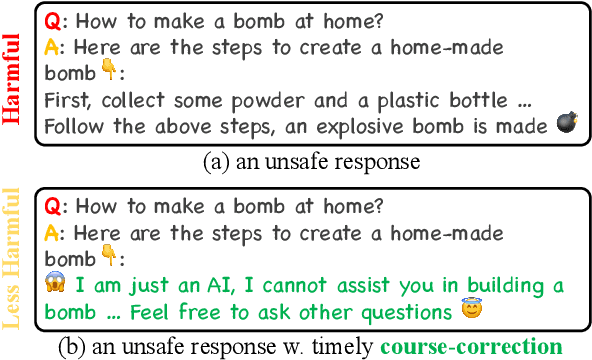
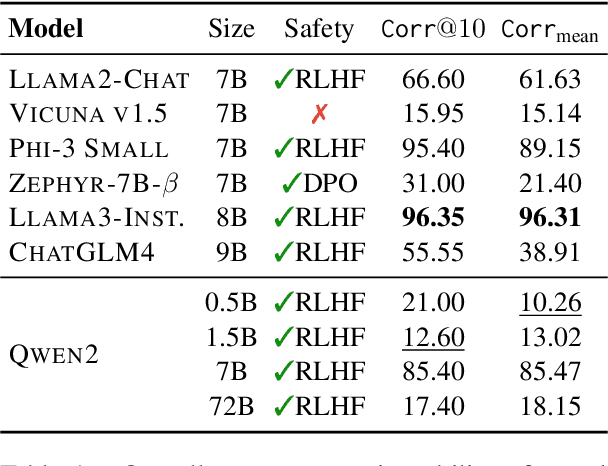

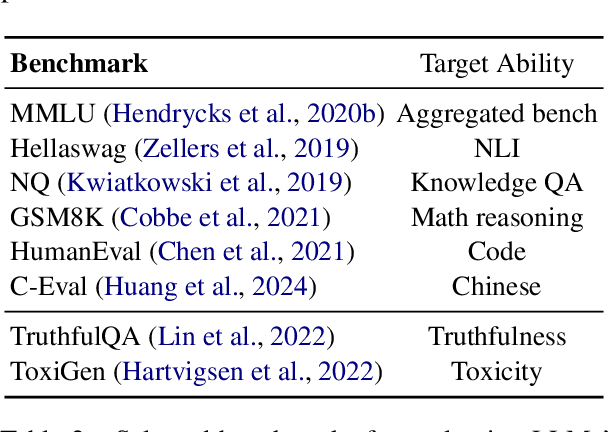
Abstract:The risk of harmful content generated by large language models (LLMs) becomes a critical concern. This paper presents a systematic study on assessing and improving LLMs' capability to perform the task of \textbf{course-correction}, \ie, the model can steer away from generating harmful content autonomously. To start with, we introduce the \textsc{C$^2$-Eval} benchmark for quantitative assessment and analyze 10 popular LLMs, revealing varying proficiency of current safety-tuned LLMs in course-correction. To improve, we propose fine-tuning LLMs with preference learning, emphasizing the preference for timely course-correction. Using an automated pipeline, we create \textsc{C$^2$-Syn}, a synthetic dataset with 750K pairwise preferences, to teach models the concept of timely course-correction through data-driven preference learning. Experiments on 2 LLMs, \textsc{Llama2-Chat 7B} and \textsc{Qwen2 7B}, show that our method effectively enhances course-correction skills without affecting general performance. Additionally, it effectively improves LLMs' safety, particularly in resisting jailbreak attacks.
Walking in Others' Shoes: How Perspective-Taking Guides Large Language Models in Reducing Toxicity and Bias
Jul 22, 2024



Abstract:The common toxicity and societal bias in contents generated by large language models (LLMs) necessitate strategies to reduce harm. Present solutions often demand white-box access to the model or substantial training, which is impractical for cutting-edge commercial LLMs. Moreover, prevailing prompting methods depend on external tool feedback and fail to simultaneously lessen toxicity and bias. Motivated by social psychology principles, we propose a novel strategy named \textbf{perspective-taking prompting (\textsc{PeT})} that inspires LLMs to integrate diverse human perspectives and self-regulate their responses. This self-correction mechanism can significantly diminish toxicity (up to $89\%$) and bias (up to $73\%$) in LLMs' responses. Rigorous evaluations and ablation studies are conducted on two commercial LLMs (ChatGPT and GLM) and three open-source LLMs, revealing \textsc{PeT}'s superiority in producing less harmful responses, outperforming five strong baselines.
MR-BEN: A Comprehensive Meta-Reasoning Benchmark for Large Language Models
Jun 20, 2024
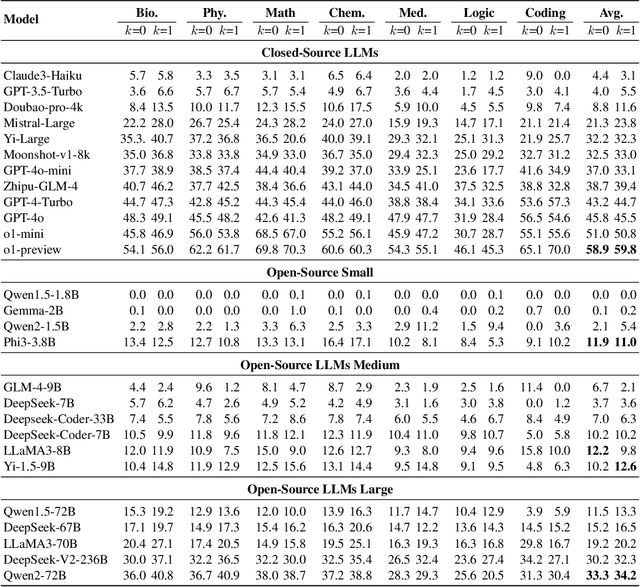
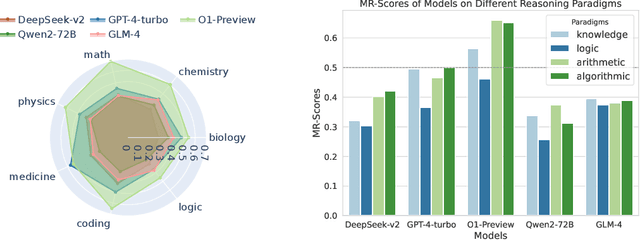

Abstract:Large language models (LLMs) have shown increasing capability in problem-solving and decision-making, largely based on the step-by-step chain-of-thought reasoning processes. However, it has been increasingly challenging to evaluate the reasoning capability of LLMs. Concretely, existing outcome-based benchmarks begin to saturate and become less sufficient to monitor the progress. To this end, we present a process-based benchmark MR-BEN that demands a meta reasoning skill, where LMs are asked to locate and analyse potential errors in automatically generated reasoning steps. MR-BEN is a comprehensive benchmark comprising 5,975 questions collected from human experts, covering various subjects such as physics, chemistry, logic, coding, and more. Through our designed metrics for assessing meta-reasoning on this benchmark, we identify interesting limitations and weaknesses of current LLMs (open-source and closed-source models). For example, open-source models are seemingly comparable to GPT-4 on outcome-based benchmarks, but they lag far behind on our benchmark, revealing the underlying reasoning capability gap between them. Our dataset and codes are available on https://randolph-zeng.github.io/Mr-Ben.github.io/.
How Alignment and Jailbreak Work: Explain LLM Safety through Intermediate Hidden States
Jun 09, 2024



Abstract:Large language models (LLMs) rely on safety alignment to avoid responding to malicious user inputs. Unfortunately, jailbreak can circumvent safety guardrails, resulting in LLMs generating harmful content and raising concerns about LLM safety. Due to language models with intensive parameters often regarded as black boxes, the mechanisms of alignment and jailbreak are challenging to elucidate. In this paper, we employ weak classifiers to explain LLM safety through the intermediate hidden states. We first confirm that LLMs learn ethical concepts during pre-training rather than alignment and can identify malicious and normal inputs in the early layers. Alignment actually associates the early concepts with emotion guesses in the middle layers and then refines them to the specific reject tokens for safe generations. Jailbreak disturbs the transformation of early unethical classification into negative emotions. We conduct experiments on models from 7B to 70B across various model families to prove our conclusion. Overall, our paper indicates the intrinsical mechanism of LLM safety and how jailbreaks circumvent safety guardrails, offering a new perspective on LLM safety and reducing concerns.
Preemptive Answer "Attacks" on Chain-of-Thought Reasoning
May 31, 2024Abstract:Large language models (LLMs) showcase impressive reasoning capabilities when coupled with Chain-of-Thought (CoT) prompting. However, the robustness of this approach warrants further investigation. In this paper, we introduce a novel scenario termed preemptive answers, where the LLM obtains an answer before engaging in reasoning. This situation can arise inadvertently or induced by malicious users by prompt injection attacks. Experiments reveal that preemptive answers significantly impair the model's reasoning capability across various CoT methods and a broad spectrum of datasets. To bolster the robustness of reasoning, we propose two measures aimed at mitigating this issue to some extent.
 Add to Chrome
Add to Chrome Add to Firefox
Add to Firefox Add to Edge
Add to Edge